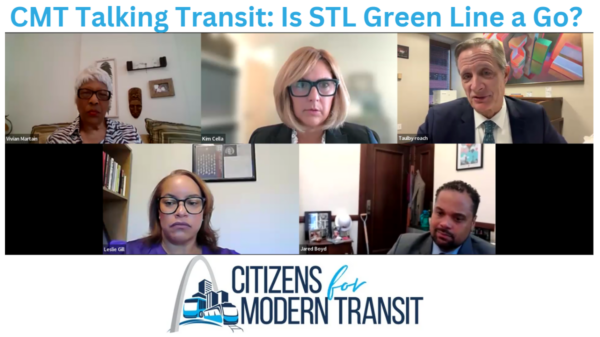 Panelists Participating in the Virtual Discussion Reinforce the Project is About People, Accessibility and Economic Equity
Panelists Participating in the Virtual Discussion Reinforce the Project is About People, Accessibility and Economic Equity
A status update on the proposed St. Louis MetroLink Green Line and associated development, accessibility, community and economic opportunities were discussed during Citizens for Modern Transit’s (CMT) “Talking Transit” event, hosted on Oct. 16 via Zoom. More than 60 CMT members, elected officials, stakeholders and transit riders were online for the virtual meeting.
Those in attendance heard from panelists Taulby Roach, President & CEO of Bi-State Development, which is responsible for project planning, design, construction, operation and maintenance of the proposed MetroLink Green Line; and Jared Boyd, Chief of Staff for the City of St. Louis Mayor’s Office, which is working closely with Bi-State Development and its project management consultant to ensure the federal planning process is followed and the public is involved. Leslie Gill, President & CEO of Rung for Women, and Vivian Martain, President of the St. Louis Chapter of the Conference of Minority Transportation Officials (COMTO), were also on hand to discuss impacts on local businesses and industry. The discussion was moderated by Kimberly Cella, the executive director of Citizens for Modern Transit.
The conversation kicked off by the panelists providing an overview of the proposed St. Louis MetroLink Green Line, which is set to include 10 stations and 5.6 miles of in-street light rail trains running on Jefferson Avenue at Chippewa Street in South St. Louis to Natural Bridge Avenue in North St. Louis, while connecting with the current MetroLink system via a transfer station. The proposed Green Line is automobile competitive, with an end-to-end travel time of 19 minutes. There are currently 28,900 residents within a half mile of the stations, and the estimated average daily ridership is 5,200 riders per day. The cost to operate the St. Louis MetroLink Green Line is projected to be $6.5 million annually, and the capital cost to build the new line is estimated at $1.1 billion.
After the overview, panelists provided the following key updates on the proposed St. Louis MetroLink Green Line:
- The project has entered into the federal process, called Project Development under the New Starts Criteria.
- Partners will look to secure federal funding for a majority – 60% or $600 million – of capital costs by submitting for a Federal Transportation Transit Administration (FTA) grant. As part of this process, the project must prove to be an affordable project under its current criteria. There is a two-year window to supply all necessary documentation.
- The partners hope to also avail of low-interest bonds through the TIFIA program for 20 percent of the cost.
- Any federal funding secured requires 50-60 percent local match. A significant amount of these matching funds would come from the economic development tax passed in the City of St. Louis on April 4, 2017. The ballot language called for 60 percent of tax revenues to go to light rail expansion in the Northside-Southside corridor. This tax funding is limited for use on this project only.
- The project is currently undergoing the environmental review process as part of National Environmental Policy Act. This is required for projects seeking to secure federal funding in order to ensure it does not significantly impact environmental resources, low-income individuals or communities of color in a negative way. Water resources, land use and acquisitions, air quality, noise and vibration, farmlands and soils, hazardous materials, wildlife and threatened and endangered species are among the many items on the list to be studied. Results will be shared with the public in spring 2025.
- Key public outreach efforts are ongoing. More than 40 neighborhood meetings have been held since May 2023 and more are scheduled. These conversations are important as they allow residents to provide their insights on the project.
- The current project timeline calls for going out for construction bids as soon as 20 months from now if a federal funding award is successfully secured.
In reference to the economic development sales tax passage in 2017, Boyd, who is Chief of Staff for the City of St. Louis Mayor’s Office, made the following comment during the discussion: “Voters overwhelmingly supported the expansion of MetroLink,” he said. “We have been able to accumulate approximately $60 million already and will continue to accrue $14 million a year for ongoing expenses. The money will be used for the local match in hopes of drawing down federal resources. Most people pay their federal taxes. It’s only right that some of that comes back to St. Louis in the form of a transformational infrastructure project like the Green Line.”
Roach, President & CEO of Bi-State Development, also discussed the impact of MetroBus service in the Northside-Southside corridor. “MetroLink accounts for approximately 30 percent of our ridership; most of it is bus oriented. We are required by federal law not to reduce bus service. It has to be reconfigured, so it works together as part of a unified system.”
The discussion also heavily focused on the importance of accessibility and economic equity. “The Green Line will help us to directly connect to employers,” said Gill, President & CEO of Rung for Women, during the discussion. Rung for Women is located along the proposed new alignment and serves as a career accelerator, helping women – 60% percent of whom are of color – upskill and reskill for jobs available now and in the future. “Accessibility is incredibly important as many of our members come from North City and North County. This North-South investment makes accessibility to our campus a real benefit, allowing us to connect more women to new career opportunities so they can change the trajectory of their lives, their family’s lives and the next generation. This proposed project is really about an investment in people.”
To view the discussion in its entirety, click here or view below.
